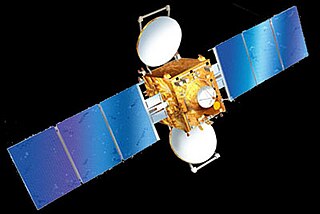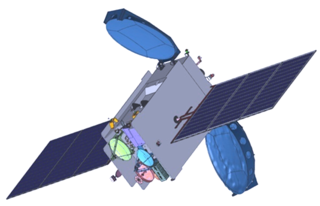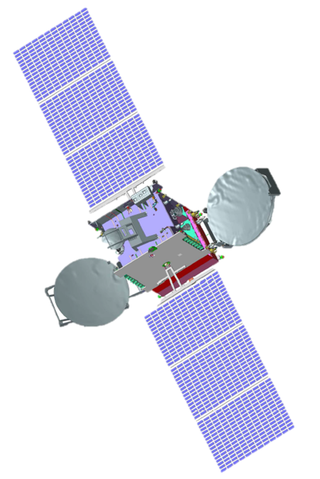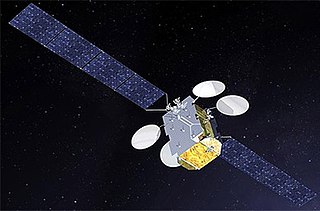| Mission type | Communication |
|---|---|
| Operator | New Space India Limited [1] [2] |
| Mission duration | 15 years (estimated) |
| Spacecraft properties | |
| Bus | I-3K Bus |
| Manufacturer | ISRO Satellite Centre Space Applications Centre |
| Launch mass | 4700 kg |
| Power | 2 solar array batteries |
| Start of mission | |
| Launch date | September 2024 (planned) [3] |
| Rocket | Falcon 9 Block 5 [3] |
| Launch site | CC, SLC-40/LC-39A |
| Contractor | SpaceX |
| Orbital parameters | |
| Reference system | Geocentric |
| Regime | Geostationary |
| Longitude | 55° East[ citation needed ] |
GSAT-20 (also known as CMS-03 or GSAT-N2) is a communication satellite being developed by Indian Space Research Organization [4] and will be launched by a SpaceX Falcon 9. [3] The GSAT-20 satellite is funded, owned and operated by New Space India Limited. [5] The entire capacity onboard CMS-02 satellite will be leased to Dish TV. [1] [6] GSAT-20 will be a continuation of GSAT series of communication satellites. The satellite is intended to add data transmission capacity to the communication infrastructure required by Smart Cities Mission of India.
The satellite features a Ka-band high-throughput communications payload with 70 Gbit/s [7] throughput utilizing 40 beams offering HTS capacity of nearly 48Gpbs. [8] Each beam will have 2 polarisations, effectively making them 80 beams. [9]
The satellite was initially expected to be launched in 2024 on an LVM 3, [10] [11] [12] but shifted to Falcon 9 due to the satellite being 700 kg overweight for a successful launch on indigenous platforms. [13]
Hence, the commercial arm of ISRO ,New Space India Limited has signed a contract with SpaceX for a possible liftoff in the second quarter of 2024. The SpaceX deal also signifies a significant as till now India had relied heavily on the France led Arianespace consortium to launch its the heavy communication satellites, particularly on the now retired Ariane 5, which ISRO was hoping as a backup. The fact that the next few launches of the Ariane 6, its successor having been both booked and delayed for launch, ISRO turned to SpaceX. India's own rockets lack the capacity for launching very heavy satellites to the geostationary orbit beyond 4 ton class, a problem that is planned to be fixed with the introduction of the NGLV. [14] [15]

The Indian National Satellite System or INSAT, is a series of multipurpose geostationary satellites launched by the Indian Space Research Organisation (ISRO) to satisfy telecommunications, broadcasting, meteorology, and search and rescue operations. Commissioned in 1983, INSAT is the largest domestic communication system in the Indo-Pacific Region. It is a joint venture of the Department of Space, Department of Telecommunications, India Meteorological Department, All India Radio and Doordarshan. The overall coordination and management of INSAT system rests with the Secretary-level INSAT Coordination Committee.

The GSAT satellites are India's indigenously developed communications satellites, used for digital audio, data and video broadcasting. As of 5 December 2018, 20 GSAT satellites manufactured by ISRO have been launched, out of which 14 are in service.

The Launch Vehicle Mark-3 or LVM3 is a three-stage medium-lift launch vehicle developed by the Indian Space Research Organisation (ISRO). Primarily designed to launch communication satellites into geostationary orbit, it is also due to launch crewed missions under the Indian Human Spaceflight Programme. LVM3 has a higher payload capacity than its predecessor, GSLV.

INSAT 3E is a defunct communication satellite built by Indian Space Research Organisation. It was launched on September 28, 2003, from the European Space Agency's spaceport in French Guiana on board the Ariane rocket. The satellite had a launch mass of 2750 kilograms. It is the 4th satellite launched in the INSAT-3 series for INSAT. It was designed for providing high-speed communication, Television, VSAT & Tele-education services and was an important landmark in Indian Space Programme.
GSAT-10 is an Indian communication satellite which was launched by Ariane-5ECA carrier rocket in September 2012. It has 12 KU Band, 12 C Band and 6 lower extended c band transponders, and included a navigation payload to augment GAGAN capacity. Following its launch and on-orbit testing, it was placed in Geosynchronous orbit at 83.0° East, from where it will provide communication services in India.

GSAT-11 is an Indian geostationary communications satellite. The 5854 kg satellite is based on the new I-6K Bus and carries 40 transponders in the Ku-band and Ka-band frequencies, which are capable of providing up to 16 Gbit/s throughput. GSAT-11 is India's heaviest satellite.
High-throughput satellite (HTS) is a communications satellite that provides more throughput than a classic FSS satellite for the same amount of allocated orbital spectrum, thus significantly reducing cost-per-bit. ViaSat-1 and EchoStar XVII do provide more than 100 Gbit/s of capacity, which is more than 100 times the capacity offered by a conventional FSS satellite. When it was launched in October 2011 ViaSat-1 had more capacity (140 Gbit/s) than all other commercial communications satellites over North America combined.
GSAT-15 is an Indian communication satellite similar to GSAT-10 to augment the capacity of transponders to provide more bandwidth for Direct-to-Home television and VSAT services. It was successfully launched on 10 November 2015 at 21:34:07 UTC aboard an Ariane 5 rocket, along with the ArabSat 6B satellite.
GSAT-16 is the 11th Indian communication satellite, meant to increase the number of transponders available for satellite-based telecommunication, television, and VSAT services in India. GSAT-16 is similar to GSAT-15 with each satellite weighing 3,150 kg and having power generation capacity of 6.8 kW.

The South Asia Satellite, formerly known as SAARC Satellite, is a geostationary communications and meteorology satellite operated by the Indian Space Research Organisation for the South Asian Association for Regional Cooperation (SAARC) region. The satellite was launched on 5 May 2017. During the 18th SAARC summit held in Nepal in 2014, Indian Prime Minister Narendra Modi mooted the idea of a satellite serving the needs of SAARC member nations as a part of his neighbourhood first policy. Afghanistan, Bangladesh, Bhutan, Maldives, Nepal and Sri Lanka are the users of the multi-dimensional facilities provided by the satellite.

GSAT-17 is an Indian communications satellite. Built by ISRO and operated by INSAT, it carries 24 C-band, 2 lower C-band, 12 upper C-band, 2 CxS, and 1 SxC transponders. It additionally carries a dedicated transponder for data relay (DRT) and search-and-rescue (SAR) services. At the time of launch, GSAT-17 was the heaviest satellite built by ISRO.

GSAT-18 is an Indian communications satellite. Built by ISRO and operated by INSAT, it carries 24 C-band, 12 extended C-band, and 12 Ku-band transponders.

GSAT-29 is a high-throughput communication satellite developed by the Indian Space Research Organisation (ISRO). The mission aims at providing high-speed bandwidth to Village Resource Centres (VRC) in rural areas. The two Ku and Ka operational payloads will provide communication services to Jammu and Kashmir and Northeast India under Digital India programme. At the time of launch GSAT-29 was the heaviest satellite, weighing 3,423 kg (7,546 lb), that was placed in orbit by an Indian launch vehicle. Approved cost of GSAT-29 is ₹175.63 crore (US$21 million).

GSAT-31 is a high-throughput telecommunication satellite developed by the Indian Space Research Organisation (ISRO).

NewSpace India Limited (NSIL) is a Public Sector Undertaking (PSU) of the Government of India and under Department of Space. NSIL is responsible for producing, assembling and integrating the launch vehicle with the help of industry consortium. It was established on 6 March 2019 under the administrative control of the Department of Space (DoS) and the Company Act 2013. The main objective of NSIL is to scale up private sector participation in Indian space programmes.

GSAT-30 is a telecommunications satellite developed by the Indian Space Research Organisation (ISRO).

Eutelsat Konnect is a geostationary communications satellite operated by Eutelsat. The satellite was designed and manufactured by Thales Alenia Space on the Spacebus NEO 100 platform, and was launched on 16 January 2020 on an Ariane 5 ECA. The satellite provides broadband internet and communications coverage to Europe and Sub-Saharan Africa.
CMS-01 is a communication satellite designed and developed by the Indian Space Research Organisation (ISRO). This satellite is a replacement of the aging GSAT-12 at 83.0° E. This satellite was successfully launched by PSLV-C50 launch vehicle on 17 December 2020 at 10:11 UTC.
CMS-02 is an Indian Communication Satellite built by ISRO. The CMS-02 satellite is funded, owned and operated by New Space India Limited. Cost of spacecraft was around ₹400 crore. The entire capacity onboard CMS-02 satellite will be leased to Tata Play. The satellite was placed into orbit by using Ariane 5 rocket.
To facilitate in-flight connectivity for automobile services using the Ka-band the space agency is planning to launch the GSAT-20 high throughput satellite next year.
{{cite news}}: |last= has generic name (help)